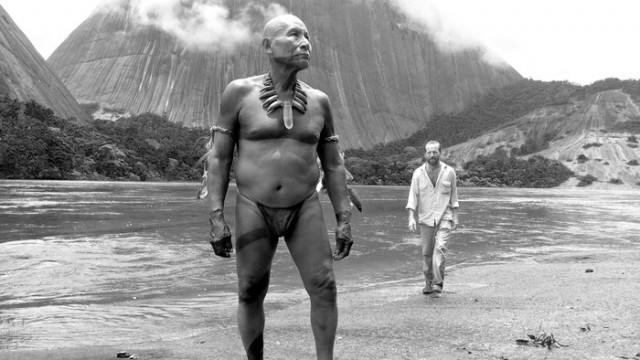Columbia’s Foreign Language Oscar nominee Embrace of the Serpent is a story about cultures and knowledge lost in the face of white culture’s corruption. Amazonian shaman Karamakate, the last of his tribe, connects two storylines in 1909 and 1940 as he leads two separate white travelers on an expedition in search for the yakruna, a rare (fictional) healing MacGuffin plant. In 1909, young Karamakate lives isolated from his people and from any other native culture until he’s recruited by a sick German explorer and his native guide, Theo and Manduca, to find the plant and reconnect Karamakate with his people. In a parallel story in 1940, old Karamakate lives isolated from his people and from any other native culture until he’s recruited by an American to look for the same plant.
By using the two timelines, Embrace of the Serpent explores the cause and effect of native cultures exposed to western cultures. By 1909, white rubber barons have already thrown Amazonian tribes into a state of upheaval through violent enslavement or pure genocidal profiteering. But, Theo’s positive influence further throws cultures into shock. In between the two explorations, Karamakate has lost himself and his connection to the Earth. He returns to his own isolation, where he struggles to remember the knowledge he has lost over the years of remaining in a holding pattern. Other cultures touched by Theo’s influence have disappeared, changed, or dropped into madness.
Both journeys follow the same river, constantly paddling upstream into the depths of morality. Ciro Guerra makes direct callbacks to both 2001 and Apocalypse Now, positing the idea that knowledge and assimilation aren’t necessarily positive developments, possibly leading to decimation and destruction. Theo introduces a compass to one tribe, and another learns the tools of Christian religion. Because the pocket nature of the tribes have few members compared to the force of white development, few are strong enough to embrace the new developments while maintaining their culture.
Though the acting here is good, the real star of this show is the cinematography. Relative newcomer David Gallego uses a stark black and white image to emphasize the differences between native and modern cultures. His widescreen framing uses every inch of the screen to communicate isolation, distrust, doom, and ritual. There’s dynamic change in every frame, with echoes of contempt for old cannibal exploitation cinematography. Embrace of the Serpent isn’t just about the change of culture, but about how our understanding of other culture is effected by the construction of our communiques from this worlds most of us won’t experience first hand.
Guerra is a learned filmmaker, creating symbols, mirrors and reflections that straddle across time lines. Embrace can be picked apart and dissected for references and cross-references creating a tapestry of continuous culture. If there are flaws, it’s in the finale (which, flawed as it might be, still manages to be a further reflection and distortion of everything that preceded it) and in Guerra’s inability to trust his audience to take the correct message from any given scene. Though Guerra offers plenty to work with, he offers little wiggle room to play with. Still, Embrace of the Serpent is a gorgeous film that offers plenty of depth while rewarding observation and memory.

